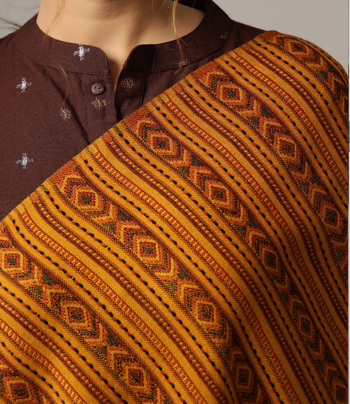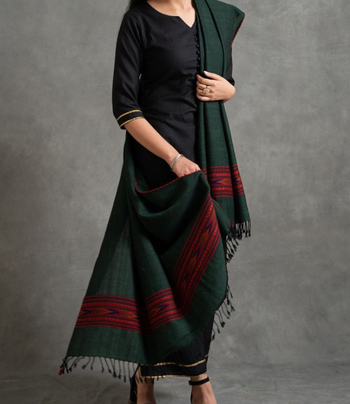Kullu Shawl
Kullu Shawls are named after Kullu Valley, the place of origin, in the State of Himachal Pradesh. The Kullu Shawl has been in existence for about the last 200 years. Kullu town is situated on the right bank of river Beas at an altitude of 1230 metres above mean sea level in the western Himalayan State of Himachal Pradesh. The Kullu valley is also known as Valley of Gods. The Kullu town has a rich heritage and the references of Kullu are found in many historical books. In ancient times Kullu was known as Kulant peeth (which means the end of the habitable world). The Weaving and designing of Kullu Shawls are now continued by local people of Kullu valley, done by weavers on hand looms in Kullu valley. A number of co-operative societies have also been formed and these societies have given employment to thousands of local workers.
However, a large number of Kullu Shawls are weaved on traditional hand looms in villages by individual weavers. A Geographic map of the shawl manufacturing area is enclosed. Kullu Shawl is considered to be of good quality and texture. Textures, method of weaving are its unique features. The yarn used to manufacture the Shawl is still spun by traditional methods and fabricated on Khaddis (Traditional Handlooms). Skilled labour is required for carrying out designing and weaving operations to maintain optimum production. Kinds of yarn used to manufacture the Shawls are local wool, Merino wool, Angora, Pashmina, synthetic yarn, cotton, and Yak wool. The fabric is also used to make Kullu caps, mufflers, dressing material with traditional Kullu patterns. Wool testing laboratories have been set up by Bhuttico and Central Wool Development Board, Ministry of Textiles Govt. of India at Kullu.
Kinnauri Shawl
The people of Kinnaur in Himachal Pradesh have traditionally been referred to as Kinners. The term Kinnaur is also widely used. The Kinnauras consist of the Rajputs or Khosias and the Berus. Widely renowned for the intricacy and finesse in weaving, Kinnauri Shawls are unique.The mythological history of Kinnaur is fascinating, Kinnaur was inhabited by tribes in the early ages. It was visited by the Pandavas of Mahabharata fame during their periods of hiding. This land finds mention in ancient legends as Kinnerdesh of Kimpurusha Khand. Many people of Kinnaur believe themselves to be the descendants of the Pandavas of the great Hindu epic, Mahabharata. The elaborate geometrical designs are unique for Kinnauri Shawls. Many of the motifs woven have a special symbolic and religious significance. The colours used for ground are white, black, natural grey and brown. The main colours used for patterning are red, orange, pink, blue, green, yellow, black and white. Out of these five colours represent five elements—white stands for water, yellow for earth, red for fire, green for air and blue for ether. Many times, they have patterned borders running all along the four edges thereby increasing the labour involved and making Kinnauri shawls are more expensive than Kullu Shawls. Most of the shawls for commercial use are woven on the frame loom, though the ones for local use are still woven on the pit loom. Here the weaver weaves it in two pieces of half width each and later joins them from the centre with elaborate hand stitching. This serves the dual purpose of function and ornamentation.
The Kinnauri people have been known to weave and some of the woven items still occupying the commonplace are: Pattu – A woollen fabric draped by women like a stole. Dohru – A woollen fabric “saree” worn by women. Shawl – A light woollen fabric draped around the shoulders and chest by women. Chaddar – A gents shawl. Patti – Local tweed used for coats, jackets and trousers. In terms of placement of the pattern/ design the Kinnauri Shawls are of three main types: i) Single Border: Kinnauri geometrical pattern along the both ends of the Shawl ii) Single Export: Kinnauri pattern running across the four edges. It takes about a month to weave a single shawl.
Intellectual Property India



